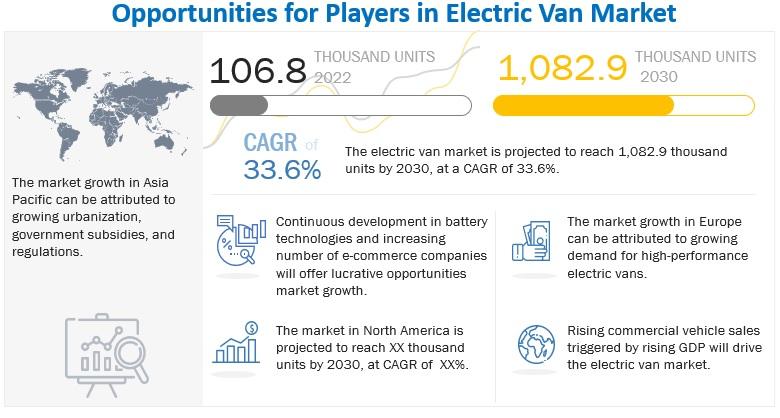Electric Van Market Projected to Reach 1,082.9 Thousand Units by 2030

The global electric van market, valued at 106.8 thousand units in 2022, is projected to expand to 1,082.9 thousand units by 2030, growing at a CAGR of 33.6% from 2022 to 2030. Key markets include the US, Japan, China, Germany, and the UK, where demand for eco-friendly vehicles is high. However, adoption in countries like India and South Korea is limited due to challenges such as insufficient charging infrastructure and high costs. Europe's stringent emission regulations and substantial government incentives are driving significant growth in the electric van sector, particularly in logistics, e-commerce, and public transportation.
By propulsion, BEV segment to highest growth rate during the forecast period
An electric van that runs completely on a battery is termed a BEV. The van runs with the help of a permanent magnet motor powered by a battery installed in the vehicle. Electric motors used in BEVs have high efficiency¯about 90% compared to ICE which is about 30-40%. The average range of BEVs varies based on battery type installation. The vans installed with the BEV propulsion system are generally used for last-mile delivery purposes. Since last-mile delivery is the most common application for electric vans, BEVs are expected to witness strong demand in the near future. Further, the electricity used to power the vans costs less than diesel fuel, which further lowers the operational costs for vans. With advancements in battery technology and a continuous decrease in battery prices, the overall costs of BEVs are expected to decrease in the coming years.
Europe estimated to account for largest market size during the forecast period
Europe has stringent emission regulation standards, and governments in this region provide huge incentives to promote electric vehicles. As a result, the demand for electric vans has increased tremendously in the region. The region is home to major manufacturers of electric vans such as Renault, Iveco, LEVC, and Fiat. Europe has set a goal of reducing 80% of CO2 emissions by 2050 as announced by the European Union and has, thus, created a roadmap for the same. In April 2021, DHL Express announced the purchase of 100 E-Ducato electric vans from Fiat to electrify its last-mile deliveries in Europe. The growing charging infrastructure due to rising demand for EV fast-charging infrastructure and the increasing prevalence of range anxiety among EV users are also driving the electric van market.
Driver: Increasing demand for emission-free and energy-efficient mass transit solutions
The transport sector is one of the largest contributors to global greenhouse gas (GHG) emissions. According to the United Nations Environment Program (UNEP), the transport sector contributes around one-quarter of greenhouse gas (GHG) emissions and is one of the largest sources of air pollution. Vehicle emissions are responsible for discharging 29% of ozone-depleting substances that bring air pollution and are dangerous to the atmosphere. Various governments across the globe have introduced initiatives to make their urban public transport system more sustainable and fuel-efficient with the use of electric vans. The introduction of electric vans will change mass transit worldwide in the coming years by improving air quality, reducing noise levels, and increasing fuel efficiency.
Restraint: Low vehicle range hampers long-distance logistics
Many electric commercial vehicle fleet owners are concerned about the range or distance covered in a single charge. The driving range of electric vans is shorter than that of ICE commercial vans. Many ECVs cover distances between 80 miles and 120 miles because of the low energy density of batteries. The maximum coverage of an ECV is ~300 miles. Users prefer covering long distances without interruptions, especially for long trips, and a long-range EV is significantly high priced. This factor could inhibit the growth of the electric van market. Various R&D efforts are undertaken to reduce the space required for housing and contacts so that more batteries can be accommodated, and the van range can be increased to approximately 600 miles. FCEVs have a huge opportunity for electric vans due to the less demand for frequent charging (which hampers commercial use in many cases).
Opportunity: Government support for electrification of public transport
In order to drive the commitment to reduce greenhouse gas (GHG) emissions and improve air quality in urban areas, governments across the globe have been providing lucrative fiscal incentives to promote shared mobility and clean transportation. Governments across the globe have launched attractive initiatives and schemes to facilitate the adoption of electric vehicles. Governments in developed countries have begun the tender process to increase the use of electric vans in their cities. For instance, as of March 2022, Royal Mail conducted its delivery using 3,000 electric vans. The roll-out largely follows cities with low-emission zones, including London, Bristol, Glasgow, Cambridge, and Oxford. The induction of e-vans will add to the emission reduction commitments at the local level. The benefits will be much greater with the simultaneous greening of electricity generation in highly populated cities like China, Japan, and India.
Content Source:
https://www.marketsandmarkets.com/PressReleases/electric-van.asp
- Art
- Causes
- Crafts
- Dance
- Drinks
- Film
- Fitness
- Food
- الألعاب
- Gardening
- Health
- الرئيسية
- Literature
- Music
- Networking
- أخرى
- Party
- Religion
- Shopping
- Sports
- Theater
- Wellness
- IT, Cloud, Software and Technology


